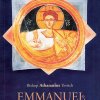by Milos Rastovic
On May 24, 2016, on behalf of His Grace Bishop MAXIM of the Western American Diocese of the Serbian Orthodox Church in North and South America, Father Branislav Golic and I presented the book Christian Heritage of Kosovo and Metohija as a gift to the Gumberg Library at Duquesne University. On behalf of the Gumberg Library and Duquesne University, the book was accepted by Dr. Sara Baron, University Librarian, who expressed thanks for the gift, welcomed all guests, and introduced speakers.
Dr. James Swindal, Professor and Dean of McAnulty College and Graduate School of Liberal Arts, welcomed Rev. Father Golic and I from the Serb National Federation. He stressed Duquesne’s mission: “Duquesne, as a Spiritan University, is dedicated to the Holy Spirit. The role of the Holy Spirit is God’s love for us is to bring unity. A unity that in biblical contexts brought energy to the witness of those to the Christian faith. More specifically, Duquesne University is committed – as through Spiritans who guide our mission – to interreligious dialogue. It is in fact a hallmark of our Department of Theology.” He also expressed gratitude to Milos Rastovic and the Serb National Federation, who were a key in the organization of this event: “Milos was a an MA student in our Philosophy Department when I was Chair. But, I was not just Chair, as I was also a mentor, a coach of sorts, and a fellow traveler in all things philosophical and political… I could not imagine a better Cultural Ambassador for Serbia, and one who is a true philosopher, than Milos.” Dr. Swindal concluded with the following words: “I am again so pleased for this gift, and note how it symbolizes a true and ongoing spirit of cooperation between Duquesne University and the Western American Diocese of the Serbian Orthodox Church – a collaboration that we trust will endure for years.”
I expressed to gratitude to speakers and stressed the exceptional effort of the Serbian Orthodox Church to publish this precious book by the Sebastian Press, the Episcopal Council of the Serbian Orthodox Church in North and South America. The book includes over 750 vivid photographs and other depictions of Serbian monasteries, churches, frescoes, icons, and historical figures of Kosovo and Metohija. In addition to the brilliant photographs and other artwork, the book includes 1,000 pages of history detailing the deep Christian heritage in this small region. It also gives a number of historical facts and tells of the Christian identity of the Serbian people in Kosovo and Metohija. I also stressed the history of Serbian Christian Culture of Kosovo and Metohija from the twelfth century to today.
Rev. Father Branislav Golic emphasized the importance of preserving the Christian Heritage of Kosovo and Metohija. He noted that there were 1300 Orthodox churches and monasteries built in medieval times. Even though most of them did not survive tragic historic events, the ones that did are the pride of the Serbian Orthodox people. Fr Branislav also said that we must make every effort to preserve the Serbian spiritual and historic values in Kosovo and Metohija for generations to come.
Dr. Radu Bordeianu, Professor of Theology, was grateful for this gift to the University and expressed what a great opportunity professors, students and colleagues will have to read and study this precious book about Christian Heritage of Kosovo and Metohija.
The book was originally presented by His Grace Bishop MAXIM at a lecture “Christian Heritage of Kosovo and Metohija” at the Cathedral of Learning, University of Pittsburgh on June 11, 2015. The lecture was sponsored by the Serb National Federation in cooperation with the Yugoslav Room Committee of the University of Pittsburgh.
The book is the single-most important compendium of research and photographs of Serbian Christian heritage of Kosovo and Metohija and is vitally important to remain available to the largest possible section of the public as a learning tool. His Grace Bishop MAXIM pointed out that the original texts that accompany the photos “demonstrate that Serbia’s architectural and art monuments in Kosovo rank among the finest achievements of medieval Europe.” His Grace hopes that the book will further convince the public of the importance of preservation of these treasures of Serbian Christian heritage not just for Christians in Kosovo and Metohija, but for world culture.
More information about the book is available on the website of the Western American Diocese of the Serbian Orthodox Church in North and South America: http://www.westsrbdio.org/.
Source: AMERICAN SRBOBRAN, Wednesday, July 20, 2016




